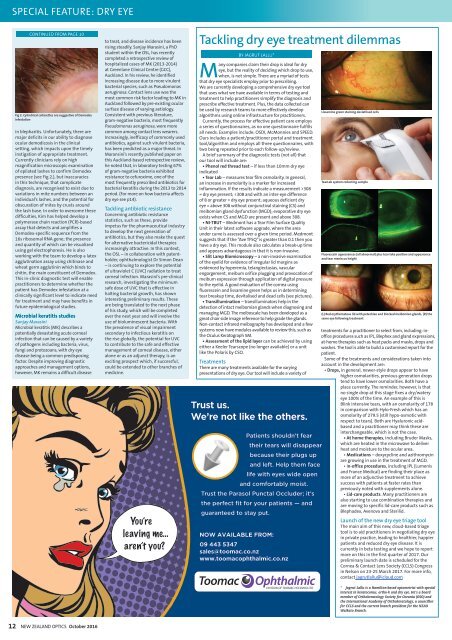Oct 2016
Create successful ePaper yourself
Turn your PDF publications into a flip-book with our unique Google optimized e-Paper software.
SPECIAL FEATURE: DRY EYE<br />
CONTINUED FROM PAGE 10<br />
Fig 2. Cylindrical collarettes are suggestive of Demodex<br />
infestation<br />
in blepharitis. Unfortunately, there are<br />
major deficits in our ability to diagnose<br />
ocular demodicosis in the clinical<br />
setting, which impacts upon the timely<br />
instigation of appropriate treatment.<br />
Currently clinicians rely on high<br />
magnification microscopic examination<br />
of epilated lashes to confirm Demodex<br />
presence (see Fig 2.), but inaccuracies<br />
in this technique, that complicate<br />
diagnosis, are recognised to exist due to<br />
variations in mite numbers between an<br />
individual’s lashes, and the potential for<br />
obscuration of mites by crusts around<br />
the lash base. In order to overcome these<br />
difficulties, Kim has helped develop a<br />
polymerase chain reaction (PCR)-based<br />
assay that detects and amplifies a<br />
Demodex-specific sequence from the<br />
16s ribosomal RNA gene; the presence<br />
and quantity of which can be visualized<br />
using gel electrophoresis. He is also<br />
working with the team to develop a latex<br />
agglutination assay using chitinase and<br />
wheat germ agglutinin which binds to<br />
chitin, the main constituent of Demodex.<br />
This in-clinic diagnostic test will enable<br />
practitioners to determine whether the<br />
patient has Demodex infestation at a<br />
clinically significant level to indicate need<br />
for treatment and may have benefits in<br />
future epidemiological studies.<br />
Microbial keratitis studies<br />
Sanjay Marasini<br />
Microbial keratitis (MK) describes a<br />
potentially devastating acute corneal<br />
infection that can be caused by a variety<br />
of pathogens including bacteria, virus,<br />
fungi and protozoans, with dry eye<br />
disease being a common predisposing<br />
factor. Despite improving diagnostic<br />
approaches and management options,<br />
however, MK remains a difficult disease<br />
to treat, and disease incidence has been<br />
rising steadily. Sanjay Marasini, a PhD<br />
student within the OSL, has recently<br />
completed a retrospective review of<br />
hospitalized cases of MK (2013-2014)<br />
at Greenlane Clinical Centre (GCC),<br />
Auckland. In his review, he identified<br />
increasing disease due to more virulent<br />
bacterial species, such as Pseudomonas<br />
aeruginosa. Contact lens use was the<br />
most common risk factor leading to MK in<br />
Auckland followed by pre-existing ocular<br />
surface disease of varying aetiology.<br />
Consistent with previous literature,<br />
gram-negative bacteria, most frequently<br />
Pseudomonas aeruginosa, were more<br />
common among contact lens wearers.<br />
Increasingly, inefficacy of commonly used<br />
antibiotics, against such virulent bacteria,<br />
has been predicted as a major threat. In<br />
Maransini’s recently published paper on<br />
this Auckland-based retrospective review,<br />
he noted that, in laboratory testing 67%<br />
of gram-negative bacteria exhibited<br />
resistance to cefuroxime, one of the<br />
most frequently prescribed antibiotics for<br />
bacterial keratitis during the 2013 to 2014<br />
period. (For more on how bacteria affects<br />
dry eye see p14).<br />
Tackling antibiotic resistance<br />
Concerning antibiotic resistance<br />
statistics, such as these, provide<br />
impetus for the pharmaceutical industry<br />
to develop the next generation of<br />
antibiotics, but they also make the quest<br />
for alternative bactericidal therapies<br />
increasingly attractive. In this context,<br />
the OSL – in collaboration with patentholder,<br />
ophthalmologist Dr Simon Dean<br />
– is continuing to explore the potential<br />
of ultraviolet C (UVC) radiation to treat<br />
corneal infection. Marasini’s pre-clinical<br />
research, investigating the minimum<br />
safe dose of UVC that is effective in<br />
halting bacterial growth, has shown<br />
interesting preliminary results. These<br />
are being translated to the next phase<br />
of his study, which will be completed<br />
over the next year and will involve the<br />
use of bioluminescent bacteria. With<br />
the prevalence of visual impairment<br />
secondary to infectious keratitis on<br />
the rise globally, the potential for UVC<br />
to contribute to the safe and effective<br />
management of corneal disease, either<br />
alone or as an adjunct therapy, is an<br />
exciting prospect which, if successful,<br />
could be extended to other branches of<br />
medicine.<br />
Youʻre<br />
leaving me…<br />
arenʻt you?<br />
Tackling dry eye treatment dilemmas<br />
BY JAGRUT LALLU*<br />
Many companies claim their drop is ideal for dry<br />
eye, but the reality of deciding which drop to use,<br />
when, is not simple. There are a myriad of tests<br />
that dry eye specialists employ prior to prescribing.<br />
We are currently developing a comprehensive dry eye tool<br />
that uses what we have available in terms of testing and<br />
treatment to help practitioners simplify the diagnosis and<br />
prescribe effective treatment. Plus, the data collected can<br />
be used by research teams to more effectively develop<br />
algorithms using online infrastructure for practitioners.<br />
Currently, the process for effective patient care employs<br />
a series of questionnaires, as no one questionnaire fulfills<br />
all needs. Examples include: OSDI, McMonnies and SPEED.<br />
Ours includes a patient/practitioner portal and treatment<br />
tool/algorithm and employs all three questionnaires, with<br />
two being repeated prior to each follow-up/review.<br />
A brief summary of the diagnostic tests (not all) that<br />
our tool will include are:<br />
• Phenol red thread test – if less than 10mm dry eye<br />
indicated<br />
• Tear Lab – measures tear film osmolarity. In general,<br />
an increase in osmolarity is a marker for increased<br />
inflammation. If the results indicate a measurement >308<br />
= dry eye present;
















